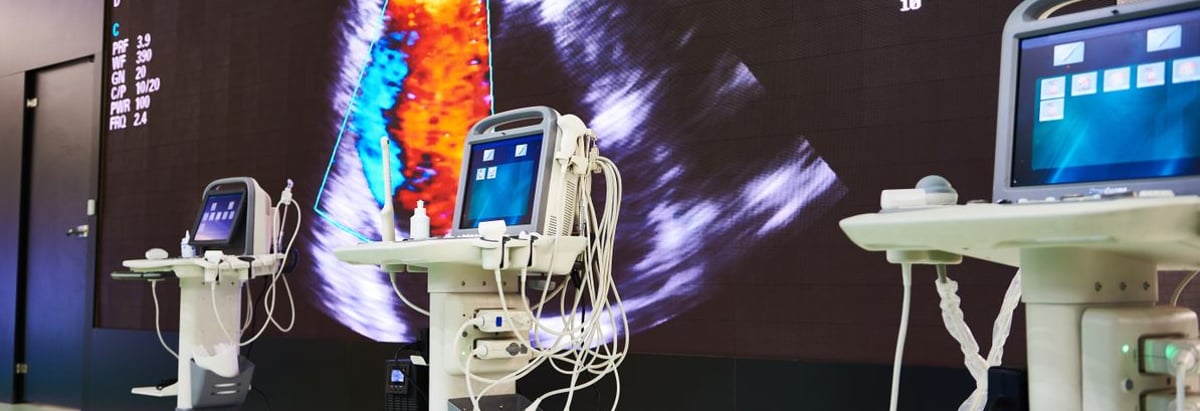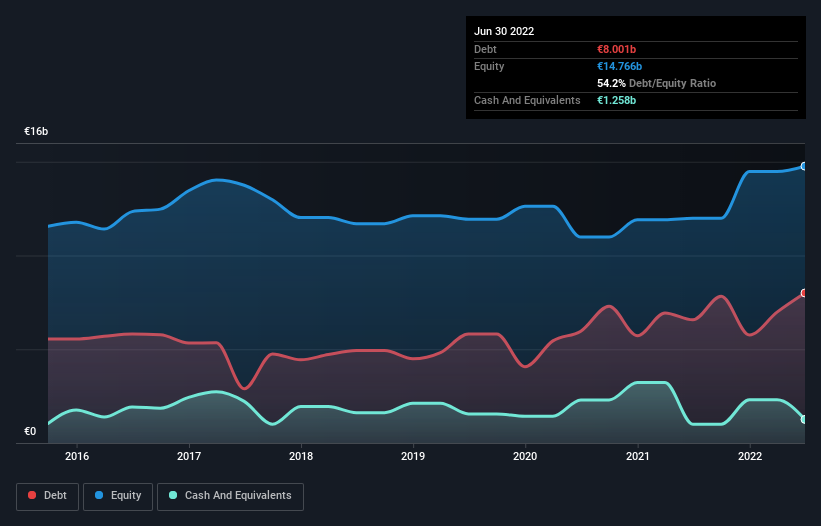- Netherlands
- /
- Medical Equipment
- /
- ENXTAM:PHIA
Here's Why Koninklijke Philips (AMS:PHIA) Has A Meaningful Debt Burden

The external fund manager backed by Berkshire Hathaway's Charlie Munger, Li Lu, makes no bones about it when he says 'The biggest investment risk is not the volatility of prices, but whether you will suffer a permanent loss of capital.' When we think about how risky a company is, we always like to look at its use of debt, since debt overload can lead to ruin. We can see that Koninklijke Philips N.V. (AMS:PHIA) does use debt in its business. But the real question is whether this debt is making the company risky.
When Is Debt Dangerous?
Debt and other liabilities become risky for a business when it cannot easily fulfill those obligations, either with free cash flow or by raising capital at an attractive price. If things get really bad, the lenders can take control of the business. However, a more usual (but still expensive) situation is where a company must dilute shareholders at a cheap share price simply to get debt under control. Of course, the upside of debt is that it often represents cheap capital, especially when it replaces dilution in a company with the ability to reinvest at high rates of return. The first thing to do when considering how much debt a business uses is to look at its cash and debt together.
Check out our latest analysis for Koninklijke Philips
How Much Debt Does Koninklijke Philips Carry?
As you can see below, at the end of June 2022, Koninklijke Philips had €8.00b of debt, up from €6.57b a year ago. Click the image for more detail. However, it also had €1.26b in cash, and so its net debt is €6.74b.

A Look At Koninklijke Philips' Liabilities
We can see from the most recent balance sheet that Koninklijke Philips had liabilities of €8.43b falling due within a year, and liabilities of €9.29b due beyond that. Offsetting this, it had €1.26b in cash and €3.81b in receivables that were due within 12 months. So it has liabilities totalling €12.7b more than its cash and near-term receivables, combined.
This deficit is considerable relative to its very significant market capitalization of €19.0b, so it does suggest shareholders should keep an eye on Koninklijke Philips' use of debt. This suggests shareholders would be heavily diluted if the company needed to shore up its balance sheet in a hurry.
We measure a company's debt load relative to its earnings power by looking at its net debt divided by its earnings before interest, tax, depreciation, and amortization (EBITDA) and by calculating how easily its earnings before interest and tax (EBIT) cover its interest expense (interest cover). Thus we consider debt relative to earnings both with and without depreciation and amortization expenses.
Koninklijke Philips has a rather high debt to EBITDA ratio of 5.1 which suggests a meaningful debt load. But the good news is that it boasts fairly comforting interest cover of 4.1 times, suggesting it can responsibly service its obligations. Even worse, Koninklijke Philips saw its EBIT tank 63% over the last 12 months. If earnings keep going like that over the long term, it has a snowball's chance in hell of paying off that debt. The balance sheet is clearly the area to focus on when you are analysing debt. But ultimately the future profitability of the business will decide if Koninklijke Philips can strengthen its balance sheet over time. So if you want to see what the professionals think, you might find this free report on analyst profit forecasts to be interesting.
But our final consideration is also important, because a company cannot pay debt with paper profits; it needs cold hard cash. So we clearly need to look at whether that EBIT is leading to corresponding free cash flow. Over the last three years, Koninklijke Philips actually produced more free cash flow than EBIT. That sort of strong cash generation warms our hearts like a puppy in a bumblebee suit.
Our View
Neither Koninklijke Philips's ability to grow its EBIT nor its net debt to EBITDA gave us confidence in its ability to take on more debt. But its conversion of EBIT to free cash flow tells a very different story, and suggests some resilience. It's also worth noting that Koninklijke Philips is in the Medical Equipment industry, which is often considered to be quite defensive. When we consider all the factors discussed, it seems to us that Koninklijke Philips is taking some risks with its use of debt. While that debt can boost returns, we think the company has enough leverage now. There's no doubt that we learn most about debt from the balance sheet. But ultimately, every company can contain risks that exist outside of the balance sheet. Be aware that Koninklijke Philips is showing 4 warning signs in our investment analysis , you should know about...
If you're interested in investing in businesses that can grow profits without the burden of debt, then check out this free list of growing businesses that have net cash on the balance sheet.
Valuation is complex, but we're here to simplify it.
Discover if Koninklijke Philips might be undervalued or overvalued with our detailed analysis, featuring fair value estimates, potential risks, dividends, insider trades, and its financial condition.
Access Free AnalysisHave feedback on this article? Concerned about the content? Get in touch with us directly. Alternatively, email editorial-team (at) simplywallst.com.
This article by Simply Wall St is general in nature. We provide commentary based on historical data and analyst forecasts only using an unbiased methodology and our articles are not intended to be financial advice. It does not constitute a recommendation to buy or sell any stock, and does not take account of your objectives, or your financial situation. We aim to bring you long-term focused analysis driven by fundamental data. Note that our analysis may not factor in the latest price-sensitive company announcements or qualitative material. Simply Wall St has no position in any stocks mentioned.
About ENXTAM:PHIA
Koninklijke Philips
Operates as a health technology company in North America, the Greater China, and internationally.
Moderate growth potential low.
Similar Companies
Market Insights
Community Narratives



